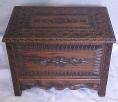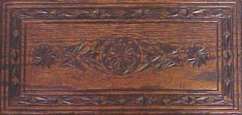 | Caithness.Org | Community | Business | Entertainment | Caithness... | Tourist Info | Site Map |
• Advertising • Chat Room • Contact Us • Kids Links • Links • Messageboard • News - Local & Scottish • News - UK & News Links • About / Contact Us • Submissions |
• Bookshop • Business Index & News • Jobs • Property For Sale • Property For Rent • Shop • Sutherland Business Index |
• Fishing • Fun Stuff • George, The Saga • Horses • Local Galas • Music • Pub Guide • Sport Index • What's On In Caithness |
• General Information • B & Bs • Backpackers • Caravan & Camping • Ferries • Getting Here • Holiday Letting • Hotels • Orkney • Pentland Firth • Sutherland • Taxis |
| N E W S F E E D S >>> |
Chip-Carving In Caithness
|
McIvor and Allan, Chip Carvers of Castletown c.1890
to c.1955 |
|
Page Two From official documents and records much is now known about the backgrounds and the lives of John McIvor and of his brother-in-law, Donald Allan. Since the first account was compiled to be issued at the Exhibition, it has been possible to know more about other members of the firm, notably James (Jimmy) Waters, who took over the firm during its final years during and after World War Two.
This short Calder history, in manuscript form, only came to light after his death, making it impossible to elaborate upon the events he described.
It was probably during the mid-1890's that the future brothers-in-law got to know each other and decided to go into partnership making and chip-carving furniture and other articles. A picture postcard, produced in 1904 for publicity purposes, shows the two partners, and in white overall, someone the writer had originally conjectured might be Jimmy Waters, who later became the joinery foreman, (an incorrect surmise as we now know that Jimmy Waters was only born in 1903! It is more likely that the person is Ben Calder, then about 18, the firm's first apprentice) and other unidentifiable older men, all standing outside the workshop. John stands awkwardly, in a pose that could indicate he suffered and injury to one of his legs. Unfortunately, it has so far proved impossible to trace an example of this postcard. Only a rather indistinct enlargement, appears to be available, one probably produced on an enlarger/photocopier. On the board bearing the name of the firm are the compass and set square, symbols denoting a connection with Freemasonry. Donald was born in Dunnet on 31 December 1858, the son of William Allan, a farm servant, and Helen nee Banks. He became a carpenter-journeyman, and on 15 February 1889, married Margaret nee Younger. They went to the United States to live, but she contracted cancer and Donald, accompanied by his younger brother William (who went to the United States for this purpose), brought his wife back to Castletown, where she died on 1 March 1893. Seven years later on 12 June 1900, he married Maria McIvor, John's sister then 24 years of age. He was described on the Marriage Certificate as "Master Carpenter" Donald appears to have been mainly responsible for the joinery aspects of the firm's products, but around the middle of the 1920's onwards, he was joined by Jimmy Waters who later became the foreman of the joinery side. However, Jimmy also learnt the technique of carving because the writer has recently see two very fine low tables made and carved by him, in very distinctive, more contemporary style.
It is therefore clear that some appreciable time prior to that year, the partners must have decided to set up in business, John having acquired the high level of skill required. They then had to obtain sets of the designs to be carved, decide on the range of articles they were to produce, find backers to put up capital to buy the house(s) and workshop that were to accommodate the firm and possibly, some of its employees, because several names are mentioned in the Valuation Rolls for a number of years. They must also, before 1902, have produced sufficient quantity of goods to demonstrate the products for sale and establish that they had a potential market, calculated production costs and sale prices. All this must have taken time, as well as business acumen, so that, effectively, the partnership must have been operating, perhaps without employees, before 1902. The writer has written evidence that the table given to him (by a direct descendant of Thomas Telford, who was important to Caithness during the early 19th C..) and displayed at the 2001 exhibition, was in the hands of the donor's mother, living in Carluke, at the very latest by 1901, because that was the year in which she sailed to Brazil to become the wife of a missionary working in that country. It was probably an advance wedding present, because it is a particularly fine article, one referred to in later catalogues as "No 2"., but it is even more elaborately carved than a number of other later examples of the same model. Perhaps because, over time, the need to reduce production costs, or to increase production, these factors led to slight simplification of carving. It could perhaps be regarded as a "special order" or a "demonstration model", but irrespective of this, its main importance is that it is one of the only such tables, or other articles, to which, so far, we can confidently attribute a date of 1900. or "definitely not later than 1901" It has not been possible to ascertain at what date the firm first produced a price list or an illustrated catalogue. There are in existence and known to the writer, three illustrated catalogues produced at various dates, showing a very large range pr [products, large and small, grandfather clock cases, tables, stools, cabinets, picture frames, bellows and so on. It is not difficult to establish their chronological order, although not their date of issue, because of price increases due, in ne case, to the impact of the Great War, but even the catalogue with the lowest prices and the smallest range of products must be later than the very earliest years of the firm. The woods used for the top-quality products were American walnut and American oak, this this which has a closer and finer grain than European oak. Many articles could also be supplied in pine, at a lesser price. Because of the relative softness and less fine grain of pine, which makes them more vulnerable when carved across the grain, the patterns are generally less elaborate, but they could be supplied in a dark stain finish. Articles in oak appear to be less common than those in walnut, although in the house of a descendant of one of the partners, stands a magnificent, large oak cabinet, not found in the catalogues, carved with the greatest precision and perfection. The writer has also seen a well-worn tray that appears to be made of sycamore. Products were made to special order and this may account for certain variations as well as one-off designs. Over the years, it is also apparent that there took place some modification of the specification and of the patterns carved on catalogue items ostensibly identical in overall shape and design. This may have been at the request of customers, or because they were made at different periods, or carved by different craftsmen. Apart from producing to order variations of catalogue items, as mentioned above, it is evident that, notably between the Wars, the firm made a number of pieces of furniture, such as nests of tables, low chairs, stools, of a character different from earlier catalogue items. These are likely to have been for special orders. They were carved, sometimes with inlaid initials or other motifs, and in later life, John McIvor decorated more than one surface carvings of thistles, complete with many leaves, and "signed" these as his own work by always carving one leaf with its tip folded back. McIvor & Allan Chip-carvers Page 3 Back To Page One Calder Carvings continue the tradition today in a direct line from the famous firm. |













